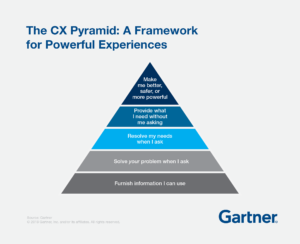 Like many CX consultants, I’ve seen my share of maturity models. Most are really good at showing all the things you’re not doing. Typically, the sponsoring company offers to help by selling you useful consulting services to help you move up the model.
Like many CX consultants, I’ve seen my share of maturity models. Most are really good at showing all the things you’re not doing. Typically, the sponsoring company offers to help by selling you useful consulting services to help you move up the model.
Whether it’s Temkin Group’s CX Maturity Model, Forrester’s six-step CX Management Maturity exam, or MaritzCX’s CXEvolution, the complex models help you evaluate your program, and each is compelling in its own way. The maturity models help you analyze what you’re doing and where you’re strong or weak.
I’ve used Gartner’s former CX model in the past and liked it. Now, while reading through October’s issue of Customer Relationship Management, I ran across the new Gartner CX Pyramid and was intrigued. I can’t find the article online, but you can review Gartner’s summary here.
It’s not that it’s more comprehensive than others. In fact, it’s rather uncomplicated, almost simplistic, but what I like about it is that rather than focusing on where you are compared to other companies, it focuses on what you do.
As a comparison, Temkin’s model has six stages: Ignore, Explore, Mobilize, Operationalize, Align and Embed. These make sense if you want to look at your program compared to others; it’s also consistent with how most maturity models work.
What I like about Gartner’s Pyramid, on the other hand, is that it shows how you respond to customers, as you can see in the graphic. It offers five levels: Communication, Responsive, Commitment, Proactive, and Evolution. They’re not as spiffy as the Temkin Group’s names, but when paired with their description, they help you quickly identify where you are, and what you need to do to better serve your customers.
At the Communications level, you “furnish information I can use,” where “you” is the company and “I” refers to the customer. Many companies are here; they have good self-service tools and lots of great information on the website for customers to find. The next level of maturity, “Responsive,” is where the company “solves your (the company’s) problem when I ask.” At this stage, the company focuses on serving customers in a way that lowers cost, such as reducing calls. Reducing calls does help customers, but it’s a really low bar for CX.
Companies at the Commitment level listen to customers and resolve their problems when they ask. Most companies aspire to this level–to listening to customers and responding quickly and compassionately. It’s a good goal, but it’s only halfway up Gartner’s pyramid because it still requires a call. Proactive companies provide what’s needed before being asked. Some B2B companies we’ve worked with are good at this; they proactively manage customers’ supplies and provide new shipments without being asked, but most wait until the customer calls, placing them at the Responsive level.
Finally, the pyramid’s top level is Evolution. This reminds me of self-actualization from Maslow’s hierarchy of needs – these companies make me (the customer) better, safer, or more powerful. I don’t care for that description; Comcast’s internet makes customers more powerful, but I doubt they’d hit the top of any CX pyramid. The CRM article states that “the few companies that have gotten there possess the kind of customer devotion and enormous reputation that yield ‘profound and sustainable business outcomes.’”
What I especially like about this model is that it’s much easier for companies to get a grasp on why it’s important, because it includes the impact on the customer.
While it doesn’t include public-facing information on how to move up the pyramid, I suspect Gartner can help you if you ask nicely (and buy a subscription).



